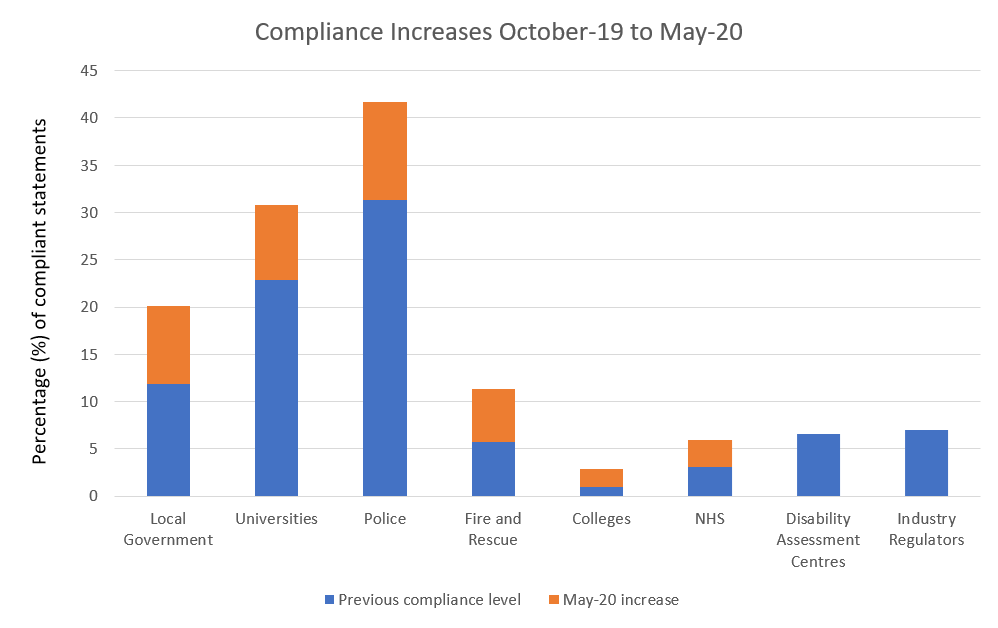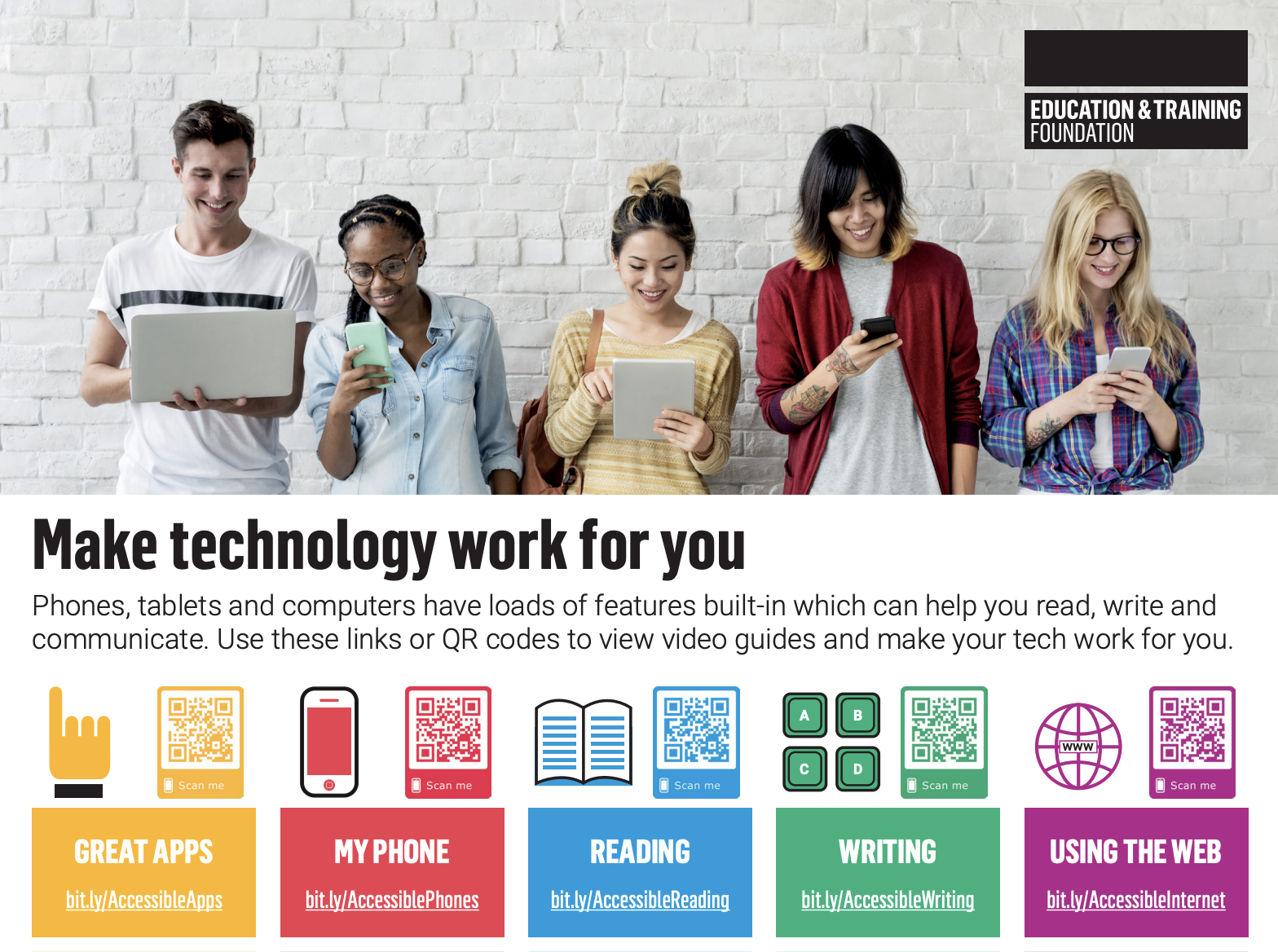What are the digital accessibility gaps in further education?
Annie Mannion | 25 Aug 2020There is just one month left before the September 23rd 2020 deadline for the Public Sector Bodies (Websites and Mobile Applications) Accessibility Regulations 2018 (PSBAR).
As part of our countdown to the regulations, this month we take a look at further education (FE) as a specific section of the public sector covered by the regulations. If you work in FE and are concerned about your ability to meet the deadline, remember there's still time to start taking actions. See our further resources at the end of the article.
To find out more about the FE sector and its response to PSBAR, we spoke with Vikki Liogier, National Head of EdTech and Digital Skills at the Education and Training Foundation (ETF), which is the expert body for professional development and standards in Further Education (FE) and Training in England.
Research has identified that the FE sector in general is less prepared than other types of organisations in the public sector for meeting the new web accessibility regulations deadline. Why do you think this is?
What problems are unique to further education (versus higher education institutions) that might affect their ability to provide compliant accessibility statements in order to meet the deadline?
Further information: Research from George Rhodes outlines compliant accessibility statements between Oct 19 and May 20. The figures and graph below show levels of compliance from May 2020, and their growth since the previous study in October 2019:
- Local Government: 20.3% (+9.4%)
- Universities: 30.8% (+7.9%)
- Police Forces: 41.7% (+10.4%)
- Fire & Rescue Services: 11.3% (+5.7%)
- Colleges: 2.9 (+1.9%)
- NHS Organisations: 5.93% (+1.8%)
- Disability Assessment Centres: 6.6%
- Utilities Companies: 0%
- Regulators: 8.8%
- Other: 2.7%
Of 384 colleges tested in the study, only 11 had compliant statements, and 177 had no statements at all:
- Compliant Statements: 11
- Good Attempt: 5
- Partial Statements: 55
- Poor Attempt: 136
- No Statements: 177

Vikki: It's difficult to respond on behalf of the sector itself, but the FE sector, which incorporates colleges, local authority providers and adult community education providers among other organisations, has been hindered for many years in terms of funding, excessive monitoring and having to respond to a range of changing priorities such as the area review directive. This has led many colleges to become reactive as opposed to strategic. Addressing the 'must have' as opposed to the 'good to have'. Covid-19 has also had a serious impact on the main income streams of FE providers.
A case study on barriers and enablers to digital capability conducted in 2018 also identified the lack of a strategic approach to technologies and indicates that college senior leaders have a critical role to play in embedding learning technology in their organisations through developing, managing and implementing a digital strategy.
What guidance has the ETF been able to provide to teachers, leaders and trainers to support them in their roles at FE institutions to meet the PSBAR deadline?
With regards to the accessibility regulations we have contributed to Policy Connect’s article on Global Accessibility Awareness Day.
We have also released a series of webinars on accessibility which are free for all to access.
In addition, we created a SEND section on our website and arranged sessions focused on Accessibility at our SET conference.
Through our leadership and governance programmes, we are working with all our delivery partners (organisations like Oxford Saïd Business School and FE Associates) to ensure that online interaction conforms with the regulations. We offer information through our alumni network of participants who have been on any of our leadership and governance programmes to raise awareness and support the sector further where needed.
We contributed to the Association of Colleges' eBook 'Creating a Post Covid-19 EdTech Strategy with No-One Left Behind':
This month the @AoC_info & @UfiTrust published a new eBook tackling the biggest issues for lecturers, students & leaders during lockdown. The ETF’s @vikkiliogier, features in the eBook with an article on ‘Learning Spaces and Communities'. Read more here: https://t.co/yalFEn44OC pic.twitter.com/WAucrR1GdY
— Education and Training Foundation (ETF) (@E_T_Foundation) July 21, 2020
We have some EdTech training modules mostly aimed at teachers and trainers. For example, Accessibility and the law: Getting it right, which shows you the issues and implications of current legislation around accessibility.
We developed a Digital Teaching Professional Framework (DTPF), awarding badges for Accessibility and Dealing with Differences and Diversity on the Enhance Digital Teaching Platform. To be awarded a two-star badge, a practitioner must submit a personal reflection on a module, while for a three-star badge the same practitioner must submit a resource and a personal reflection, which will both be peer-reviewed.
The badging scheme offers an opportunity for practitioners to reflect on a specific aspect of their practice and test out new strategies and resources in their context:
“I hope teachers start to question why they can’t use certain tools/approaches and that (especially now in current lockdown) senior leaders, managers and teachers start to think about whether they can deliver curriculums in different ways,” said one reviewer.
Are there additional resources and support required by FE institutions to help them better meet the needs of the regulations? What do you think are the possible knowledge gaps?
I would say there is a gap of knowledge is in how best to apply the accessibility elements. Organisations need to be compliant and generally educators really want to do this, but it’s the detail that’s missing. How do you make your platforms and documents accessible? To support the ETF's staff across the organisation with this, my colleague Teresa Carroll, the ETF's National Head of Inclusion, delivered a webinar with our Centres for Excellence in SEND.
We are updating our webinars to include live captions, and we also delivered a series of webinars to support educators and managers from across the FE sector, with accessibility topics including:
- Making webinars more inclusive.
- Releasing the genie – helping teachers and learners tap into the potential of students’ personal devices.
- Meeting the online accessibility needs of all our learners.
We shared with our networks Jisc resources and the TES article about how colleges can become truly accessible.
We also worked with Natspec and TechAbility to publish a poster, which helps get the word out to learners and staff about accessibility features. They can then access short videos on how to use the features.

What do you think are the priorities for colleges and further education institutions to focus on in the next month while there's still time to meet the regulations deadline?
I would recommend they perform an audit of their sites to identify issues, then draw up an action plan to address non-compliance. Finally, it's vital they release an updated accessibility statement by 23 September 2020. See AbilityNet's webinar playback: HE/Public Sector Update: Is your Accessibility Statement ready yet? for useful information about this.
From your experience, are there any institutions that are to be commended for their best practice in how to meet the PSBAR deadline?
City College Norwich and the Heart of Worcestershire College have been doing some great work.
You have built up a reputation for demonstrating high digital accessibility standards, and come recommended by Alistair McNaught, a key figure in the sector. Can you share some of the digital accessibility-related activities and projects you have been working on at ETF?
EdTech Strategy and accessible learning is one of our strategic priorities that inform all our work.
The ETF developed the Enhance Digital Teaching Platform to offer clear EdTech and Digital Skills development pathways to educators. Both the platform and its programmes have been designed to remove barriers to learning and engagement and focus on the benefits of good pedagogy supported by technology to enhance learning, which include:
- Time
- Accessibility
- Know how
- Inclusion
- User experience – personalisation of learning
We adopted a user-centred design process to create an optimised user experience with a mobile first, adaptive and responsive design. EnhanceDTP embraces a strong accessibility and inclusion ethos to widen participation and uses algorithms (AI) to personalise the learning experience:
We performed two accessibility audits of the platform and programmes, and our delivery partners have since been working on their respective action plan. As a result we are drafting our accessibility statement at the moment and aim to release it in the next week or two.
We ran nine Digital Outstanding Teaching Learning and Assessment (OTLA) Projects in 2018 – these were UK teacher-led research projects.
Can you share some background into your own personal passion for ensuring digital accessibility?
I have been committed to technologies over many years, professionally across my career: as an illustrator and graphic designer, as a lecturer, and later as a digital practitioner.
Technologies are empowering and not only to some of us who may be neuro diverse but to all of us. Phones, tablet and computers have loads of features built-in which can help you read, write and communicate. Using technologies will transcend the classroom walls and connect learning to the outside world.
I strongly believe in inclusion and the value of diversity. I hate discrimination in whatever form it takes, and accessibility plays a key role in removing barriers - barriers to learning as well as barriers to independence.
As well as overseeing many other technology and accessibility related projects, I was part of the Techdis Ambassador project 2012:
Personally, my sight is not what it used to be, and I often use my mobile or iPad to take a picture of the menu when in a poorly lit restaurant or bar to enlarge the type and increase contrast. I love eBooks because they are more accessible.
Further resources
AbilityNet has a range of resources and guidance to provide you with information about the steps you can take to ensure compliance with new digital accessibility regulations for public sector organisations:
- Need help with approaching accessibility? Take a look at our resources for higher education and further education institutions
- Webinar playback: HE/Public Sector Update: Is your Accessibility Statement ready yet?
- 10 steps to comply with new accessibility regulations
- Podcast: Listen to the TechShare Procast interview with George Rhodes and Abi James
- Sign up to our enewsletter for regular accessibility updates.



